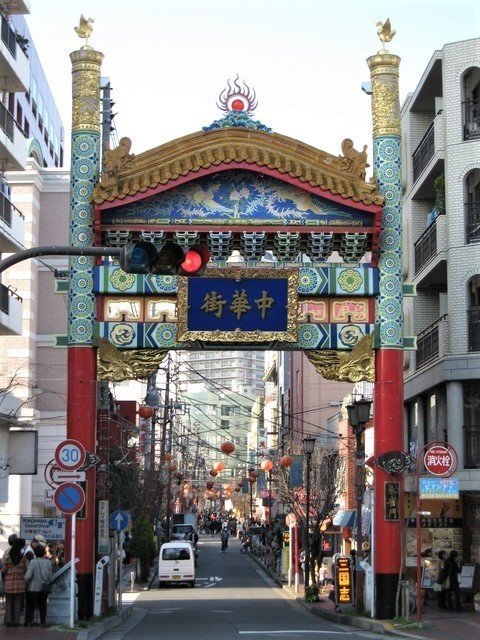
風水思想を色濃く反映している中華街の門。【横浜中華街Ⅲ】 The gate of Chinatown that strongly reflects the thought of Feng Shui.
中国では、城や寺院に必ず「門」が存在する。日本の鳥居や山門にあたるものであるが、その存在感は極めて大きい。それは、中国文化のルーツとして中国人の暮らしに根付いている「風水」というのが大きくかかわっているようだ。
In China, there is always a "gate" in every castle or temple. It is a Japanese torii gate and a temple gate, but its presence is extremely large. It seems that Feng Shui, which is rooted in the life of Chinese people as a root of Chinese culture, is greatly involved.
それを見てとれるのが、横浜中華街にある10基の門である。そのうちもっとも風水に影響された主門が、東の「朝陽門」、南の「朱雀門」、西の「延平門」、北の「玄武門」の4基である。
調べてみると、風水思想のベースになっている五行説では、それぞれの方角を表す「色」と「聖獣」が決められている。東は「青」で「青龍」。南は「朱(赤)」で「朱雀」。西は「白」で「白虎」。そして北が「玄(黒)」で「玄武」。これらのモチーフが煌びやかに反映されている見事な主門である。
You can see the 10 gates in Yokohama Chinatown. The four main gates that were most affected by Feng Shui were the Choyo Gate in the east, the Suzaku Gate in the south, the Enpei Gate in the west, and the Genbu Gate in the north.
Upon investigation, the five-way theory, which is the basis of Feng Shui's thought, determines the “color” and “sacred beast” that represent each direction. East is "blue" and "blue dragon". South is "red" and "suzaku". West is "white" and "white tiger". And the north is "Gen (black)" and "Genbu". It is a magnificent main gate in which these motifs are brilliantly reflected.
中国では古来より、皇帝が城を築くとき、城内に入ってくる邪気を見張るために東南西北のみに通路を開き、門衛を置いた。それらは「春夏秋冬」「朝昼暮夜」という陰陽五行に基づく色である「青赤白黒」で彩られ、さらに各方位の守護神として人々に根強く信仰された四神を据えたといわれている。
Since ancient times in China, when the emperor built a castle, he opened a passage only in the east-south-west-north and placed a gate guard to watch the evil that entered the castle. They are colored with "blue, red, white and black", which are colors based on the yin and yang lines of "spring, summer, autumn and winter" and "morning, evening, night, and night", and it is said that four gods deeply believed by people as guardians of each direction were set up.
横浜中華街を大きな城として、関帝廟や媽祖廟を中心に伽藍が形成され、その城内には数多くの中華飯店が軒を連ねている。それらを守る主門4基が東西南北に建てられ、守護神が邪を見張り城内(街)の繁栄と安全をはかるために大きな役割を果たしている。見て(写真)のとおり、門柱が青・赤・白・黒と色分けされている。
With China Town in Yokohama as a large castle, a cathedral is formed around the Kantei Mausoleum and Mausoleum, and there are many Chinese restaurants in the castle. The four main gates that protect them are built in the north, south, east, and west, and the guardian deity plays a major role in watching the evil and ensuring the prosperity and security of the castle (town). As you can see (photo), the gateposts are color-coded blue, red, white, and black.

朝陽門(チョウヨウモン)
日の出を迎える門。朝日が街全体を覆い繁栄をもたらす。守護神は青龍神。色は青。
Choyomon
The gate greets the sunrise. The Asahi covers the entire town and brings prosperity. The guardian deity is Blue dragon god. The color is blue.

朱雀門(スザクモン)
厄災をはらい、大いなる福を招く。守護神は朱雀神。色は赤。
Suzakumon
It causes a great disaster and invites great fortune. The guardian deity is Suzaku god. The color is red.

延平門(エンペイモン)
平和と平安のやすらぎが末永く続くことを願う。守護神は白虎神。色は白。
Enpeimon
We hope the peace and peace of peace will last forever. The guardian deity is the white tiger god. The color is white.

玄武門(ゲンブモン)
子孫の繁栄をもたらす。守護神は玄武神。色は黒。
Genbumon
Bring prosperity to the offspring. The guardian deity is Genbu god. The color is black.
レポート & 写真 / 渡邉雄二 写真の一部はネット画像より転用
Reported & Photos by Yuji Watanabe
よろしければサポートお願いします。日本の伝統文化に関心を寄せています。若いころに文化圏の異なる地域の方たちとの交流で日本のことをあまりにも知らなかったことに気づかされ、それがきっかけで広く浅く学んでいます。拙いレポートですが、お目に留めていただければ幸です。
